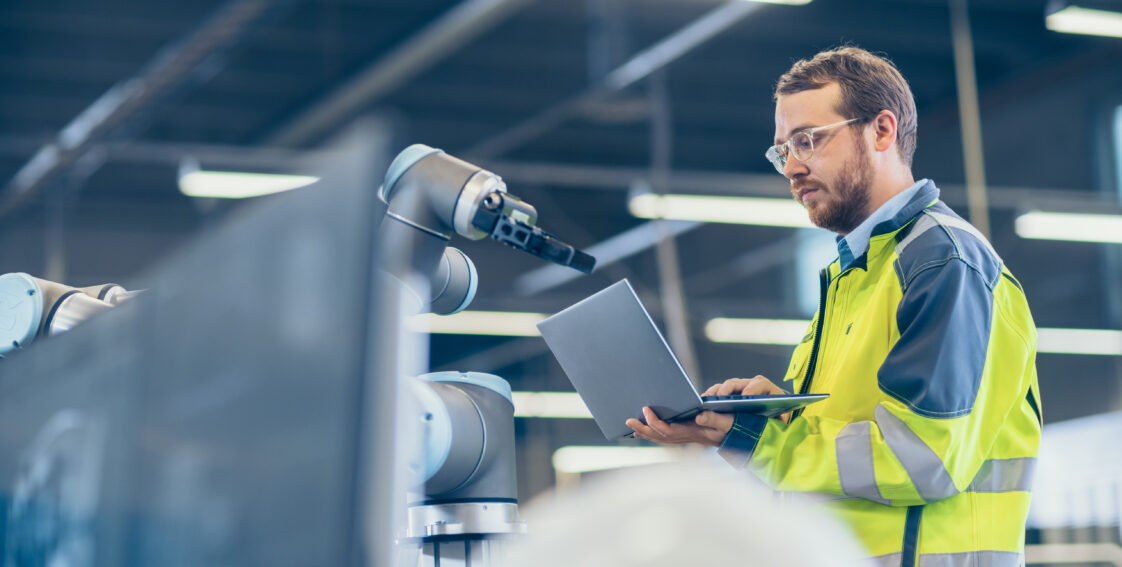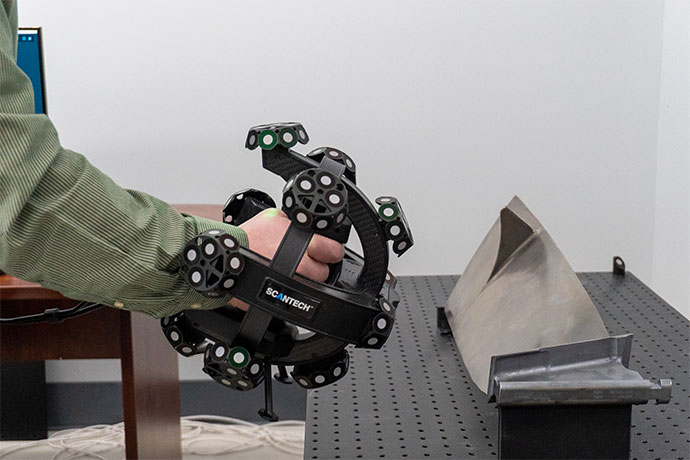
Integration Guide for 3D Measurement Technologies: Which Solution Is Right for You?
As manufacturers continue to move towards efficient, cost-effective, and smarter production processes, selecting the right 3D measurement technology is becoming more important than ever. From integration considerations to training costs and design options, there is a wide range of factors to consider.
This guide will help you understand the options available for 3D measurement technology and which option may best suit your needs.
STEP 1: DEFINE YOUR NEEDS

The first step in integrating automated inspection or measurement is to make sure you fully understand your needs. Here are some questions to ask that will help clarify the requirements for your automated scanning system:
- What measurements do you really need in order to verify compliance? Do you need a full CAD comparison or only a subset of key measurements?
- Do you need to find defects that are unique each time such as scratches, bumps, incorrectly assembled parts, etc.?
- What material types and colors will you need to inspect?
- How many parts do you need to inspect? Do you need to perform 100% inspection or only a sub-sample of parts?
- How fast do you produce parts and how much time do you have available for measurement and inspection?
- Do you already know where this inspection should fit into your overall manufacturing process?
STEP 2: CHOOSE A SYSTEM TYPE
Next, you should consider what type of automated inspection system you need.
There are several popular ways to deploy 3D scanning in manufacturing ranging from handheld systems to fully automated inline measurement robots. Choosing the right measurement technology comes down to knowing the challenges and benefits of each.
CHOOSING A MEASUREMENT TECHNOLOGY

We will look at handheld 3D scanning, automated 3D scanning, robotic 3D scanners, and fixed 3D scanners in detail and give you the information you need to make an informed decision.
HANDHELD 3D SCANNING
Handheld 3D scanners are ideal for manufacturers who need to quickly and easily scan objects but they are measuring low volumes, with a high mix, and only measuring parts infrequently. Handheld systems are portable, making them great for all types of workspaces. Using the MAS QC Plus™ software the full measurement sequence can be automated and can run when a hand scan is complete, however, these scanners are not totally automated, cannot perform inline measurements, and an operator must be present to manually control the device.
FIXED 3D SCANNERS
Fixed scanners are excellent options for manufacturers needing high-accuracy, high-repeatability 3D scanning technology when continuously scanning similar objects. They’re also ideal for manufacturers with a motion system, such as parts coming in from a machine to a conveyor or parts being moved by a robot.
Since these scanners are fixed and lack mobility, they can be difficult to mount in certain workspaces or facilities seeking space-saving solutions. Some design work may also be required to ensure a fixed scanner can be mounted on the production line. Additionally, if a robotic system is in use and the fixed scanner encounters a part defect, the active robot program may have to be changed, or the robot’s cycle time will need to be extended to resolve the issue.
AUTOMATED 3D SCANNING
While the upfront investment required in automated 3D scanning may seem high, the rewards can quickly outweigh these costs. Implementation can also be challenging on your own, especially if this is the first time you’re attempting to automate your metrology processes.
But don’t let these challenges deter you—with this technology, you’ll benefit from consistent, repeatable results that increase your efficiency while eliminating potential human error. And MAS can partner with you every step of the way to make the design and integration as painless as possible.
Automating metrology processes can open up new possibilities for your manufacturing processes and reduce the time, labor, and cost associated with performing manual measurements. MAS offers a wide range of automated 3D scanning solutions including linear motorized systems and robotic systems.
ROBOTIC 3D SCANNERS
Robotic 3D scanners are the next level up in terms of 3D measurement technology but require full application evaluation and in-depth design before implementation. If a manufacturer doesn’t already have a robotic system in place, implementing robotic scanners can be difficult, both due to scope and the requirement that all employees and operators will have to be trained in software operation.
Despite the increased integration needs, the benefits of robotic scanning are significant. They’re highly accurate, incredibly fast, and the best solution for performing inline measurements. They also have an adaptive pathing option, allowing defective parts to be automatically redirected to alternate production routes.
COBOTS VS. ROBOTS
Choosing between an industrial robot or a cobot system requires a full application analysis. Are there speed and payload requirements? Do you have the resources needed to design and integrate a robotic system? Is your team already familiar with robotic programming or will you be learning for the first time?
If your application requires high speed and precision, and design and integration aren’t an issue, an industrial robot may be the right choice. On the other hand, if your application requires workers to collaborate near a robot or you need a system that’s easier to design or integrate, you may need a cobot system.
STEP 3. CHOOSE AN AUTOMATION ROUTE

Once you’ve chosen a system and measurement technology for your specific application, it’s time to decide how to best integrate that system into your factory.
There are four primary options: offline, nearline, inline, and inline adaptive.
OFFLINE
Traditionally, metrology measurements were typically performed in a separate room and not as a part of the production line— this is called offline measurement.
Taking measurements offline is a slow and manual process that requires significant human interaction and involvement and increases the lag in measurement times versus production times. By replacing the manual processes with an automated offline system you get improved measurement consistency and more flexibility to deal with labor challenges.
There’s less special training required to run an automated measurement system and if workers are out sick or there are labor shortages, production isn’t completely halted.
Even though tighter integration into the manufacturing process is available, some measurement technologies still need to be offline, especially if strict temperature or vibration control requirements exist.
NEARLINE
Nearline measurement technology is not directly in the production line but in close proximity to it.
Although it’s slightly faster than completely offline measurements, it’s still not as fast as inline and can’t be automated to run within the production process. But if your measurement doesn’t need to be in a temperature-controlled area, then placing the automated inspection system closer to the line will shorten the feedback time and typically allows you to increase the sampling percentage you are inspecting.
INLINE
Inline measurements can be fully automated so parts and components are measured while they are going through the production line.
This is ideal for speed, requires very little human intervention, and significantly raises the sampling rate. For instance, one component could be measured every minute rather than one component per hour. Or you could even inspect every part that comes down the line before they go to the next process.
INLINE ADAPTIVE
Inline adaptive measurements feature the same benefits as inline systems, with the addition of adaptive pathing to perform post-processing. Adaptive pathing is primarily relevant in robotic systems; it allows the system to automatically change the robot’s path so that if an issue or defect within a part is detected, it can automatically be rerouted to an alternate route for automated repair or further processing. Compare this to the manual alternative, where an operator would need to pick up the part, place it into a defect bin, and take it out of the production line to be fixed. This is a slow and labor-intensive process.
Inline inspection with adaptive pathing ensures better accuracy and repeatability so you can correct problems before they happen, and Scan-to-Path™ software from MAS makes it simple.
FIND YOUR SOLUTION WITH HELP FROM MAS
Finding and implementing the right solution for 3D scanning in your factory can be difficult—that’s why MAS is here to help.
Since our founding, we’ve been committed to helping manufacturers find the most cost-effective and efficient solutions for their facilities. We specialize in designing and building precision linear, robotic, and handheld scanning systems for clients in the aerospace/defense, automotive, electric vehicle, medical, and manufacturing industries. Our systems are integrated with our proprietary QC Plus™ software, which includes a Scan-to-Path™ option for manufacturers interested in inline adaptive metrology.
If you have questions about 3D measurement technologies or want to learn more about our systems, please contact us today to schedule a discovery meeting with one of our team members.
